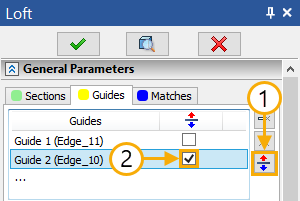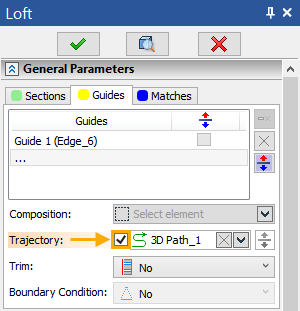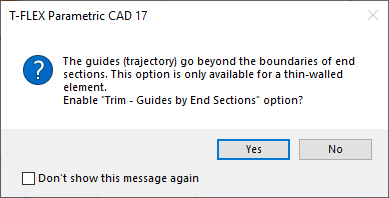Guides of Loft |
  
|
The guides are side elements of the operation skeleton.
Without Guide |
With Guide |
|
|
General information when defining guides
Elements that are selected as guides are highlighted in yellow by default. The active guide is highlighted in red.
|
1. First guide (Active) 2. Second guide |
A guide becomes active when you select it from the guide list. Color settings are made in the system options.
An arrow is drawn at the end of each guide to show the contour bypass direction. For the successful creation of the operation, it is necessary to achieve the direction from the first section to the last. For open guides, the direction is set automatically. You can change the bypass direction of a closed contour using the Reverse option.
When using closed or open contours, the system tries to establish the synchronization of the bypass directions using Autoreverse. If you want to use the Reverse option, you must first disable the Autoreverse option.

Switching the option for open contour moves the starting point to the opposite end of the contour.
Defining guides is much the same as defining sections. To switch to the guides setting mode, go to the Guides tab of the parameters window.
One 3D profile (closed/open), one 3D path (closed/open), a face (a set of faces), an edge (a set of edges) or a loop can be selected as a guide.
All available selection filters are displayed in the filter toolbar.
![]()
The guide must necessarily have intersections with all sections, including sections specified by a point.
The following automenu option is active by default:
|
<S> |
Automatic contour search |
While it's active, the system automatically decides whether selected element should be included into one of existing guides or a new guide should be added. If selected non-closed element touches one of the existing non-closed guides, such element is included into such guide; otherwise a new guide is added.
Upon disabling the ![]() option, each selected element will be added to the end of the guides list as a new guide.
option, each selected element will be added to the end of the guides list as a new guide.
Trajectory
In the Loft operation, you can select the trajectories along which the sections will move. The trajectories selection field is located on the Guides tab.

The selection of the trajectories allows the use of wire geometry, which will determine the shape of the result along all vertices of the sections. This functionality is similar to the Sweep operation, but has a number of peculiarities, for example, specifying several sections with a different number of vertices or match points.
|
|
1. Section with 4 vertices 2. Section with 6 vertices |
3. 3D Path used as a guide 4. 3D Path used as a trajectory |
If necessary, you can add both guides and trajectories at the same time. If a trajectory is selected and at least one guide is selected, the Use path as guide option will become active.

With guide only / With guide and trajectory |
With trajectory only / With guide and trajectory with enabled option |
|
|
1. Guide 2. Trajectory |
|
For the trajectory, the option to change direction is available. It allows you to move the starting point of the trajectory direction in the opposite direction.
|
1. First section 2. Second section |
The option to reverse the trajectory direction is available only when the Autoreverse option for guides is disabled.
Trimming
Guides and trajectories can be automatically trimmed if they are longer than the section boundaries. If such guides have been selected, the system will offer to enable the Trim - By End Sections option, which will allow using only that part of the guide that is located between the first and last sections.


The option is created for working with solid and surface bodies. If the Periodic Body option is enabled, trimming will not work.
Defining boundary conditions for guides is described in the Boundary Condition section.